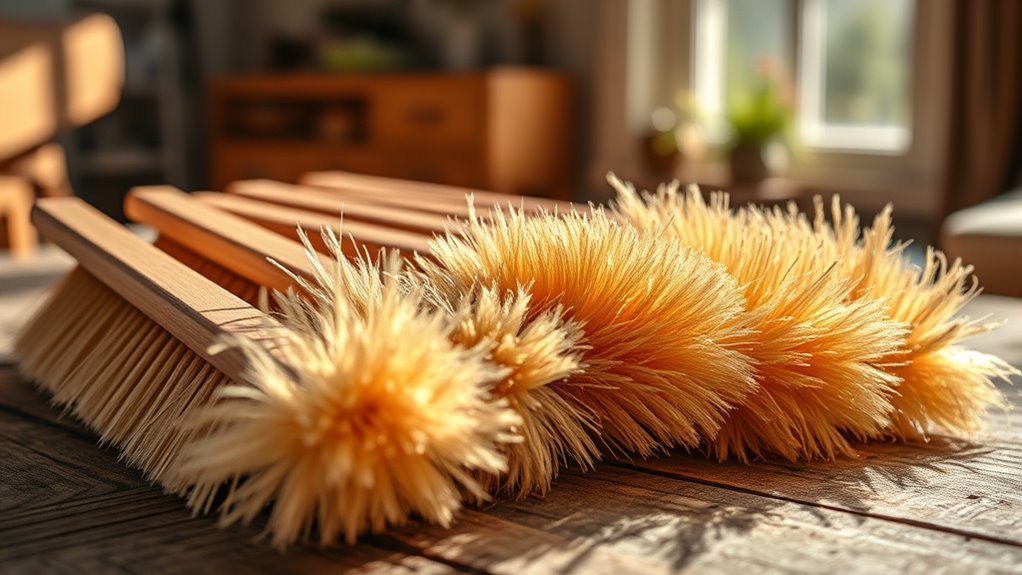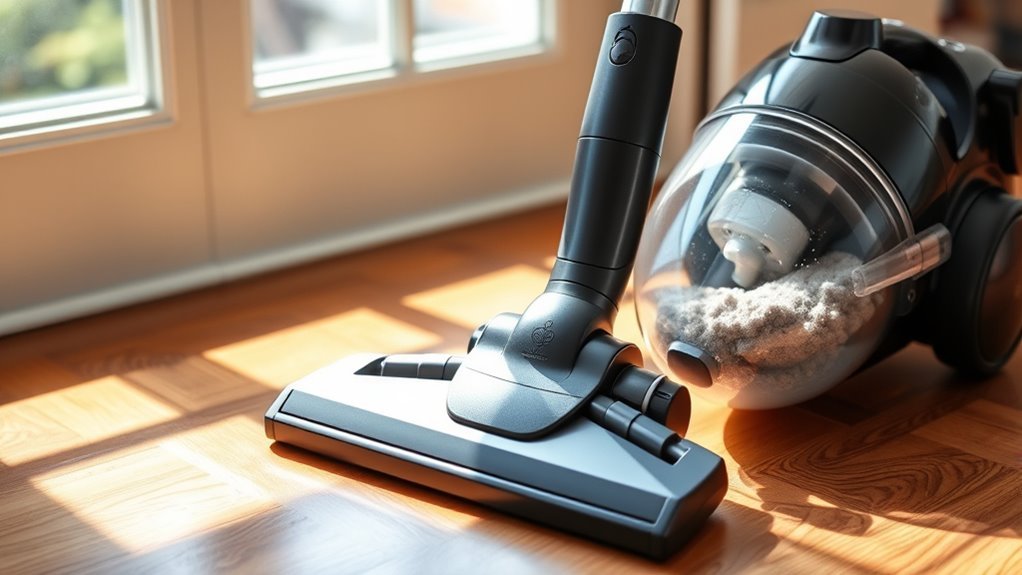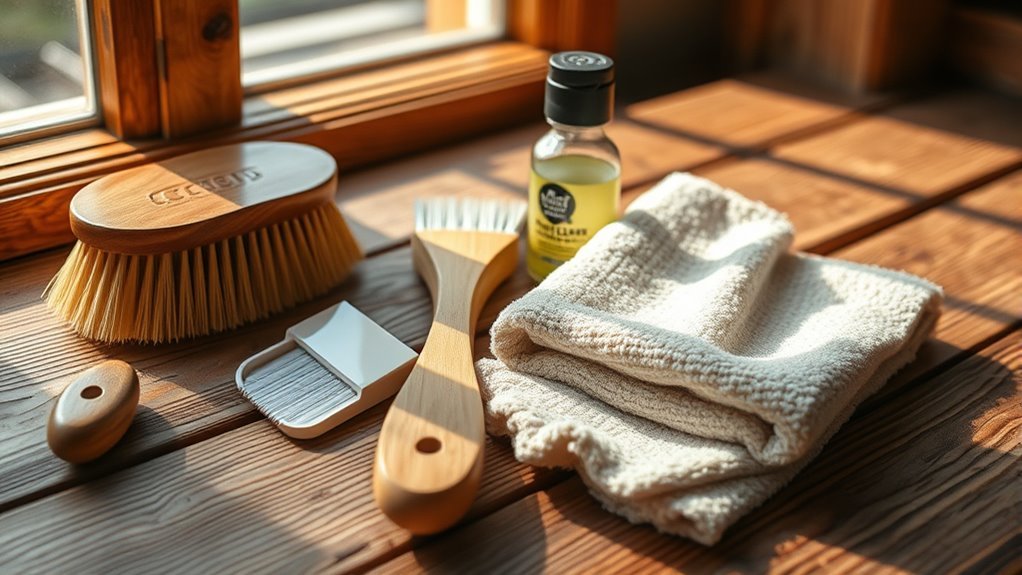Essential Tools for Cleaning Wood
You’ll want soft bristle brushes to dust wood gently without scratches, and microfiber cloths for wiping grime effectively. Vacuum cleaners with wood floor attachments help remove dirt safely, while wood-safe cleaning solutions protect finishes during cleaning. Spray bottles make applying liquids easy, and sanding sponges prepare surfaces smoothly. Don’t forget protective gloves for handling chemicals safely. Toothbrushes tackle detailed spots, and lint-free cotton cloths polish without residue. Discover how these tools improve your wood care routine even more.
Soft Bristle Brushes for Dusting

When you’re cleaning wood surfaces, soft bristle brushes are your best friend for dusting. They offer gentle yet effective cleaning, preserving the wood’s natural finish without scratching or damaging it. The soft bristle benefits include reaching into grooves and intricate details where dust loves to hide, giving you freedom from stubborn dirt without harsh chemicals. To keep your brush working its best, regular brush maintenance is key: rinse it with warm water, remove debris from bristles, and let it air dry completely. By caring for your brush, you extend its life and maintain its dusting power. Embracing these simple tools lets you clean wood with ease and respect, keeping your space fresh while protecting your freedom to care for your home naturally.
Microfiber Cloths for Gentle Wiping
Soft bristle brushes help remove dust from wood, but for wiping down surfaces, microfiber cloths are your go-to. They offer incredible microfiber benefits that make cleaning easier and gentler on your wood. You’ll appreciate how these cloths work without scratching or leaving lint behind. Here are three key cleaning techniques to maximize your microfiber cloth use:
Microfiber cloths gently clean wood surfaces without scratches or lint, making dust removal simple and effective.
- Lightly dampen the cloth with water to trap dust and dirt without soaking the wood.
- Use gentle, circular motions to lift grime without damaging the finish.
- Rinse and wring out the cloth frequently to avoid redistributing dirt.
Vacuum Cleaners With Wood Floor Attachments

Although you might rely on microfiber cloths for delicate dusting, vacuum cleaners with wood floor attachments are essential for a deeper clean. These specialized tools help you maintain the natural beauty of your floors by removing dirt and debris without scratching the surface. When choosing among vacuum cleaner brands, look for models designed specifically for hardwood floor maintenance—features like soft bristles, adjustable suction, and wide nozzles make a big difference. Using the right attachment lets you glide freely across your floors, ensuring thorough cleaning while protecting their finish. This approach frees you from worrying about damage and keeps your wood looking fresh longer. Embracing a vacuum with wood floor attachments means you can enjoy your space with confidence and ease.
Wood-Safe Cleaning Solutions
Since wood floors can be sensitive to harsh chemicals, you’ll want to choose cleaning solutions that protect their finish while effectively removing dirt. Opting for natural cleaners and eco friendly options lets you maintain your floors without compromising your health or the environment. Here are three wood-safe cleaning solutions to evaluate:
- Diluted Vinegar Solution – Mix one part vinegar with ten parts water for a gentle, effective cleaner that won’t damage your wood.
- Castile Soap – This biodegradable soap diluted in water cleans without leaving residue or harming finishes.
- Commercial Eco Friendly Wood Cleaners – Look for products labeled natural or plant-based for safe, efficient cleaning.
Spray Bottles for Even Application

A good spray bottle makes it easy to apply your chosen wood-safe cleaning solution evenly across the surface, preventing over-saturation and streaks. When picking spray bottle types, consider fine mist options for delicate wood or adjustable nozzles that let you control the spray pattern. This flexibility gives you freedom to tailor your approach depending on the wood’s texture and finish. Mastering application techniques is key—you want a light, consistent layer rather than heavy spots that can cause damage. Hold the bottle about 8-12 inches away, and move steadily across the wood in smooth, overlapping strokes. By choosing the right spray bottle and using precise techniques, you’ll guarantee your wood stays clean and protected without unnecessary waste or mess.
Wood Polish and Conditioner Products
When you want to restore shine and nourish your wood surfaces, wood polish and conditioner products are essential. These tools help maintain your wood’s natural beauty while protecting it from drying and cracking. Here’s what you need to know:
- Wood polish benefits: Polishes add a protective layer, enhancing shine and repelling dust without leaving a sticky residue.
- Conditioner application: Conditioners penetrate deep, restoring moisture and preventing wood from becoming brittle. Apply evenly for best results.
- Choosing your product: Opt for natural, non-toxic formulas to keep your space fresh and safe, supporting your freedom to live clean.
Using quality polish and conditioner regularly lets your wood breathe and glow, giving you lasting freedom from dull, lifeless surfaces.
Lint-Free Cotton Cloths
After applying wood polish or conditioner, you’ll want the right cloth to get the best finish. Lint-free cotton cloths are your go-to tool for this because they won’t leave behind fibers that spoil your wood’s natural beauty. Using proper cleaning techniques with these cloths guarantees you can buff surfaces smoothly and evenly, enhancing the wood’s shine without streaks or residue. To maintain freedom in your cleaning routine, pay attention to cloth maintenance: wash them separately using mild detergent, avoid fabric softeners, and air dry to keep them soft and lint-free. With the right care, these cloths stay effective longer, giving you consistent results every time. Choosing lint-free cotton cloths means you’re equipped to treat your wood with respect and precision.
Toothbrushes for Detailed Cleaning
Toothbrushes offer unmatched precision for cleaning the tight grooves and intricate details in wood surfaces. When you want freedom from dirt trapped in narrow spaces, choosing the right toothbrush type is key. Here are three cleaning techniques to get the best results:
- Soft-bristle brushes gently remove dust without damaging delicate wood.
- Angled toothbrushes reach stubborn corners and carvings easily.
- Firm-bristle brushes tackle tougher grime but use them cautiously to avoid scratching.
Sanding Sponges for Surface Preparation
When preparing wood, sanding sponges are a must-have because they come in various grits to suit different surfaces. You’ll find they’re great for smoothing out rough spots and prepping areas for finishing. Using the right sanding sponge will make your wood cleaning process more efficient and effective.
Types of Sanding Sponges
There are several types of sanding sponges designed to help you prepare wood surfaces effectively. Knowing the right sanding sponge types and sanding techniques can make your project smoother and more enjoyable. Here are three common types to evaluate:
- Fine Grit Sponges – Perfect for delicate finishes and light sanding, giving you control without damaging the wood.
- Medium Grit Sponges – Ideal for general surface preparation, removing old finishes or smoothing rough spots efficiently.
- Coarse Grit Sponges – Best for heavy-duty sanding, quickly tackling tough surfaces or stripping stubborn layers.
Choosing the right sponge lets you work freely, tailoring your sanding approach to the wood’s needs. With these tools, you’ll glide through prepping your wood with ease and precision.
Benefits for Wood Preparation
Although sanding sponges might seem simple, they offer several key benefits that make wood preparation easier and more effective. When you’re focused on wood surface preparation, they adapt to curves and corners, giving you smooth results without much effort. Plus, their ergonomic design means you won’t tire your hands quickly, letting you work freely and efficiently. Using sanding sponges also complements your cleaning techniques by removing grime and old finishes gently without damaging the wood.
| Benefit | Why It Matters |
|---|---|
| Flexibility | Conforms to shapes, improving surface prep |
| Ergonomic Comfort | Reduces hand fatigue, allowing longer work |
| Gentle Cleaning | Protects wood while removing dirt and old paint |
These advantages make sanding sponges a must-have for anyone serious about wood surface preparation.
Protective Gloves for Handling Chemicals
When you’re working with wood cleaning chemicals, wearing protective gloves is a must to keep your skin safe from harmful substances. You’ll want to pick gloves made from materials that resist the specific chemicals you’re using. Choosing the right gloves helps prevent irritation and guarantees you can work confidently.
Chemical Resistance Importance
Because wood-cleaning chemicals can be harsh and potentially harmful, you need protective gloves that resist corrosion and penetration. When dealing with chemical interactions, your gloves are the barrier that keeps your skin safe while preserving the wood’s surface durability. Here’s why chemical resistance matters:
- Safety: Gloves prevent harmful substances from causing irritation or burns, giving you freedom to work confidently.
- Durability: Resistant gloves maintain integrity despite exposure, so you’re not constantly replacing gear.
- Effectiveness: Proper protection lets you focus on cleaning, not on the risk of chemical damage to your hands or the wood.
Choosing gloves with strong chemical resistance guarantees you protect yourself and maintain the wood’s quality, letting you clean freely and effectively every time.
Choosing Proper Glove Material
Selecting the right glove material is essential for protecting your hands from harsh wood-cleaning chemicals. You want gloves that offer chemical resistance without sacrificing comfort or freedom of movement. Latex gloves are flexible and fit snugly, making them great for precision work, but they can cause allergies for some. Nitrile gloves provide excellent chemical resistance and durability, ideal if you’re handling stronger solvents. Here’s a quick guide to help you choose:
| Glove Material | Key Benefit |
|---|---|
| Latex Gloves | High flexibility |
| Nitrile Gloves | Superior chemical resistance |
| Vinyl Gloves | Budget-friendly |
| Neoprene | Resistant to oils and solvents |
Pick what fits your needs best, so your hands stay safe while you work freely on your wood projects.
Frequently Asked Questions
How Often Should I Clean Wooden Surfaces to Prevent Damage?
Did you know that dust can settle on wooden surfaces up to 40 times faster than you’d expect? To keep your wood looking fresh and avoid damage, you should set a cleaning frequency of once a week for light dusting and a deeper clean every few months. Sticking to a maintenance schedule gives you freedom from costly repairs and keeps your space inviting without feeling like a chore.
Can Steam Cleaners Be Used Safely on Wood?
You might wonder if steam cleaners are safe for wood surfaces. While steam cleaner benefits include deep cleaning and sanitizing without chemicals, you’ve got to be cautious. Excess moisture and heat can damage wood, causing warping or discoloration. To keep your wood surface safety intact, use a steam cleaner sparingly, test on a small area first, and avoid prolonged exposure. That way, you get a fresh clean without risking your wood’s natural beauty.
What Is the Best Way to Remove Water Stains From Wood?
Imagine a water stain screaming “Look at me!” on your wood surface. To tame that stubborn mark, you’ll want to try effective techniques like gently rubbing with a mixture of baking soda and water or using a bit of toothpaste. These simple tricks can work wonders for water stain removal without harming your wood. Just remember, patience is key—you’re aiming for freedom from stains, not a wood disaster!
Are Natural Oils Effective for Wood Cleaning and Maintenance?
You’ll find natural oils quite effective for wood cleaning and maintenance because they offer amazing oil benefits. They nourish and protect wood while keeping it looking fresh. Unlike harsh chemicals, these oils work gently, enhancing wood’s natural beauty. When exploring cleaning methods, using natural oils lets you maintain freedom in choosing eco-friendly options that don’t compromise quality. So, if you want a simple, effective way to care for your wood, natural oils are a great choice.
How Can I Prevent Wood From Warping During Cleaning?
Did you know that wood can absorb up to 30% of its weight in moisture, causing warping? To prevent this, you’ve got to master humidity control during cleaning. Keep the environment stable—too much moisture and the wood swells, too little and it cracks. After cleaning, proper drying is key; don’t rush it. Let your wood breathe freely, drying naturally to maintain its shape and preserve its natural beauty.






